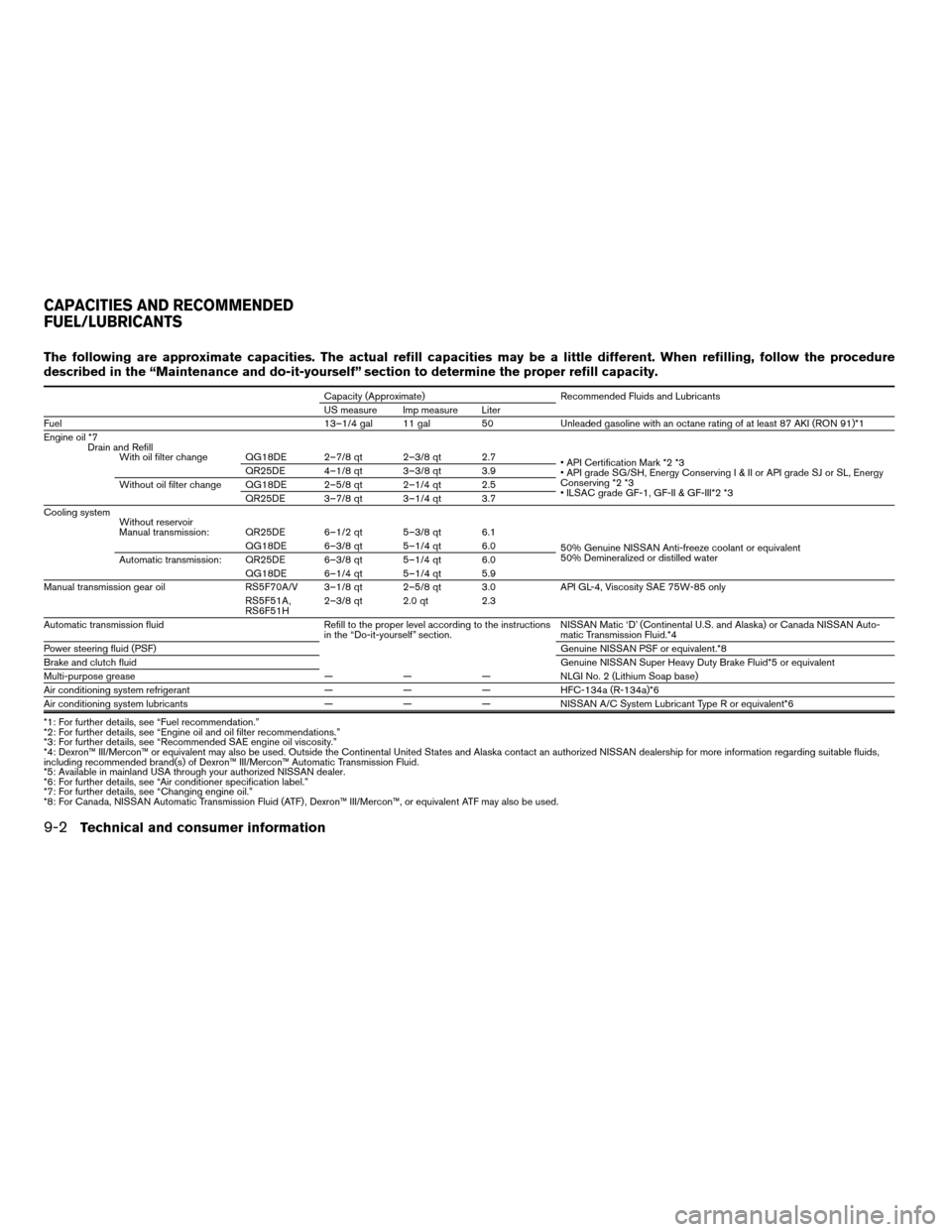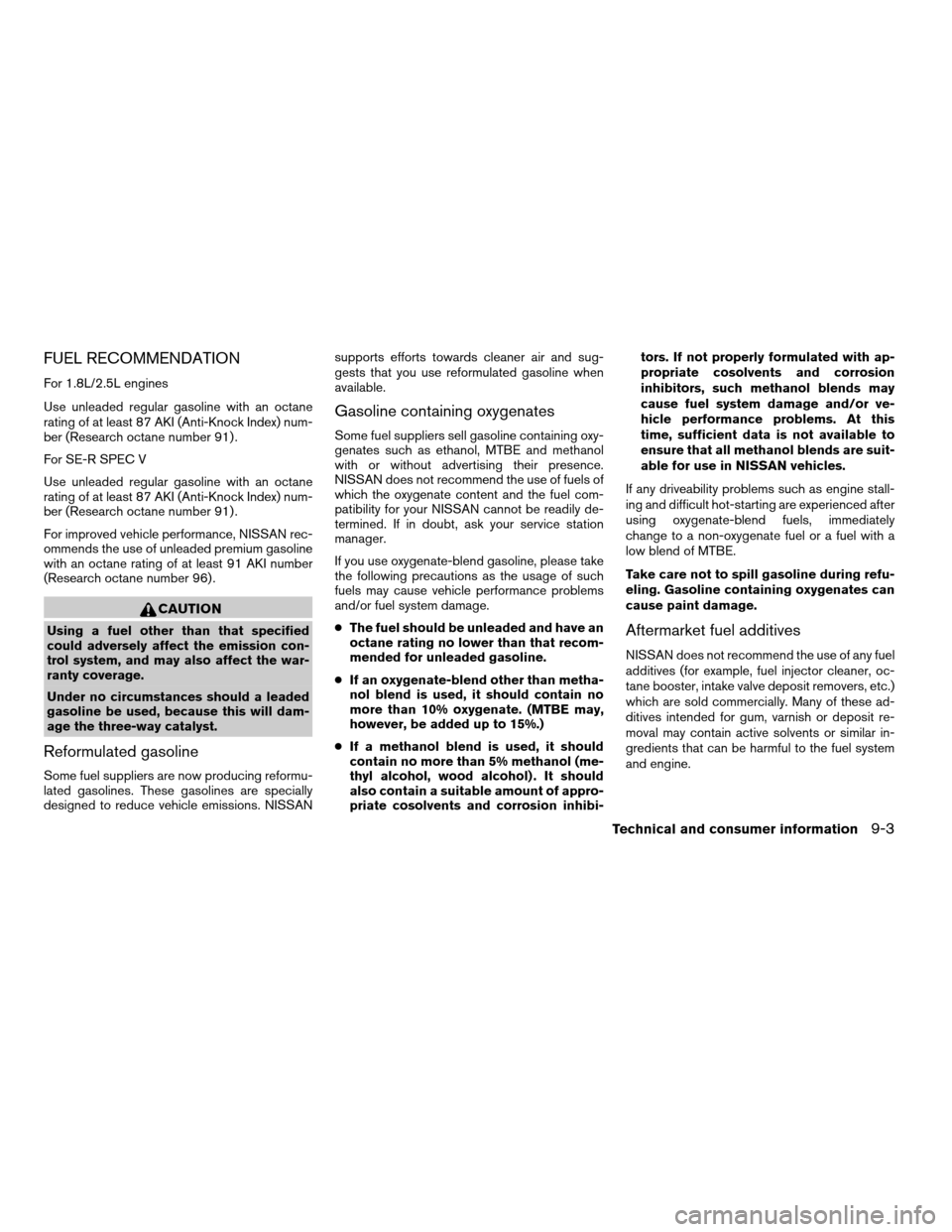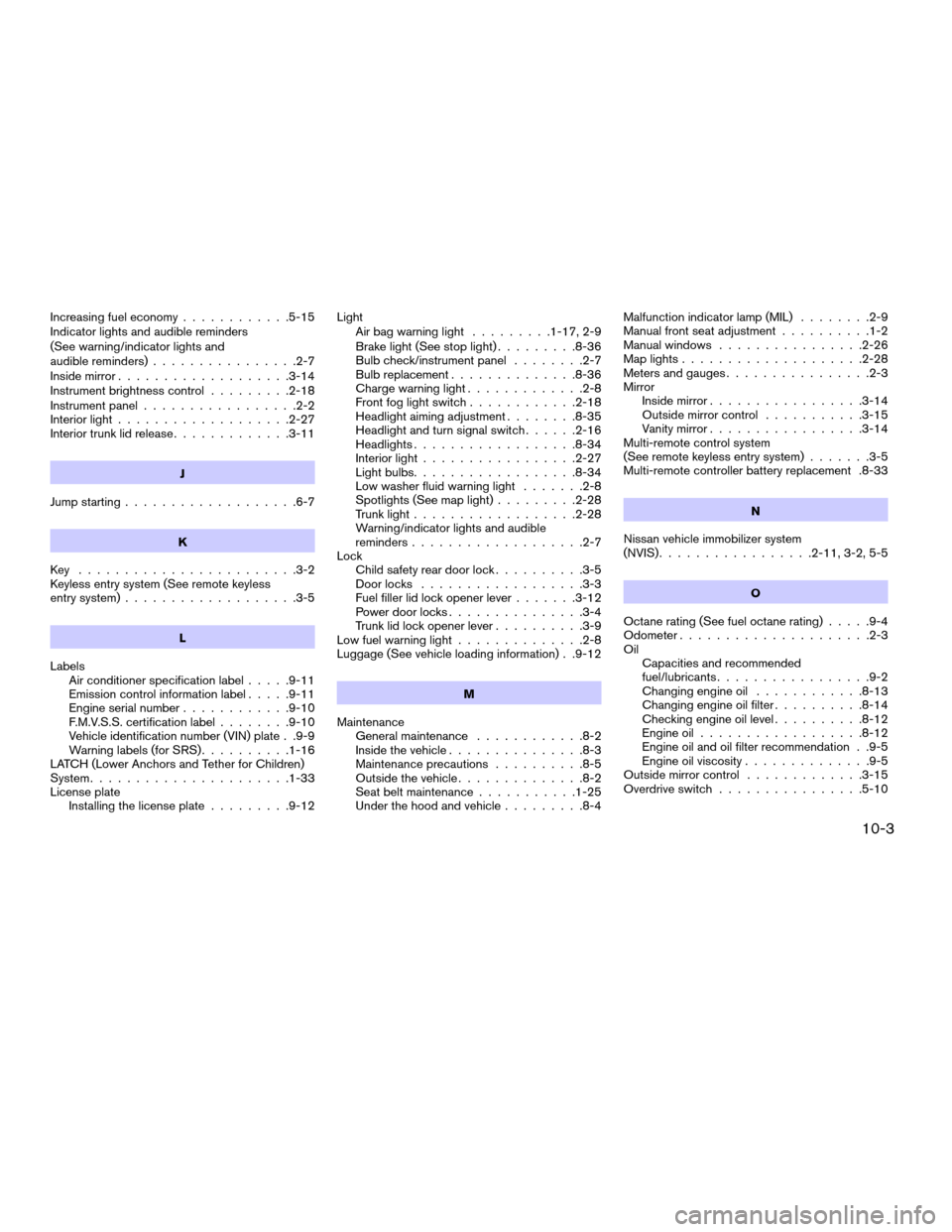2003 NISSAN SENTRA octane
[x] Cancel search: octanePage 194 of 224

The following are approximate capacities. The actual refill capacities may be a little different. When refilling, follow the procedure
described in the “Maintenance and do-it-yourself” section to determine the proper refill capacity.
Capacity (Approximate) Recommended Fluids and Lubricants
US measure Imp measure Liter
Fuel 13–1/4 gal 11 gal 50 Unleaded gasoline with an octane rating of at least 87 AKI (RON 91)*1
Engine oil *7
Drain and Refill
With oil filter change QG18DE 2–7/8 qt 2–3/8 qt 2.7
• API Certification Mark *2 *3
• API grade SG/SH, Energy ConservingI&IIorAPIgrade SJ or SL, Energy
Conserving *2 *3
• ILSAC grade GF-1, GF-II & GF-III*2 *3 QR25DE 4–1/8 qt 3–3/8 qt 3.9
Without oil filter change QG18DE 2–5/8 qt 2–1/4 qt 2.5
QR25DE 3–7/8 qt 3–1/4 qt 3.7
Cooling system
Without reservoir
Manual transmission: QR25DE 6–1/2 qt 5–3/8 qt 6.1
50% Genuine NISSAN Anti-freeze coolant or equivalent
50% Demineralized or distilled water QG18DE 6–3/8 qt 5–1/4 qt 6.0
Automatic transmission: QR25DE 6–3/8 qt 5–1/4 qt 6.0
QG18DE 6–1/4 qt 5–1/4 qt 5.9
Manual transmission gear oil RS5F70A/V 3–1/8 qt 2–5/8 qt 3.0 API GL-4, Viscosity SAE 75W-85 only
RS5F51A,
RS6F51H2–3/8 qt 2.0 qt 2.3
Automatic transmission fluid Refill to the proper level according to the instructions
in the “Do-it-yourself” section.NISSAN Matic ‘D’ (Continental U.S. and Alaska) or Canada NISSAN Auto-
matic Transmission Fluid.*4
Power steering fluid (PSF)Genuine NISSAN PSF or equivalent.*8
Brake and clutch fluidGenuine NISSAN Super Heavy Duty Brake Fluid*5 or equivalent
Multi-purpose grease———NLGINo.2(Lithium Soap base)
Air conditioning system refrigerant— — — HFC-134a (R-134a)*6
Air conditioning system lubricants— — — NISSAN A/C System Lubricant Type R or equivalent*6
*1: For further details, see “Fuel recommendation.”
*2: For further details, see “Engine oil and oil filter recommendations.”
*3: For further details, see “Recommended SAE engine oil viscosity.”
*4: Dexron™ III/Mercon™ or equivalent may also be used. Outside the Continental United States and Alaska contact an authorized NISSAN dealership formore information regarding suitable fluids,
including recommended brand(s) of Dexron™ III/Mercon™ Automatic Transmission Fluid.
*5: Available in mainland USA through your authorized NISSAN dealer.
*6: For further details, see “Air conditioner specification label.”
*7: For further details, see “Changing engine oil.”
*8: For Canada, NISSAN Automatic Transmission Fluid (ATF) , Dexron™ III/Mercon™, or equivalent ATF may also be used.
CAPACITIES AND RECOMMENDED
FUEL/LUBRICANTS
9-2Technical and consumer information
ZREVIEW COPY:Ð2003 Sentra(b15)
Owners Manual(owners)ÐUSA English(nna)
12/20/02Ðcathy
X
Page 195 of 224

FUEL RECOMMENDATION
For 1.8L/2.5L engines
Use unleaded regular gasoline with an octane
rating of at least 87 AKI (Anti-Knock Index) num-
ber (Research octane number 91) .
For SE-R SPEC V
Use unleaded regular gasoline with an octane
rating of at least 87 AKI (Anti-Knock Index) num-
ber (Research octane number 91) .
For improved vehicle performance, NISSAN rec-
ommends the use of unleaded premium gasoline
with an octane rating of at least 91 AKI number
(Research octane number 96) .
CAUTION
Using a fuel other than that specified
could adversely affect the emission con-
trol system, and may also affect the war-
ranty coverage.
Under no circumstances should a leaded
gasoline be used, because this will dam-
age the three-way catalyst.
Reformulated gasoline
Some fuel suppliers are now producing reformu-
lated gasolines. These gasolines are specially
designed to reduce vehicle emissions. NISSANsupports efforts towards cleaner air and sug-
gests that you use reformulated gasoline when
available.
Gasoline containing oxygenates
Some fuel suppliers sell gasoline containing oxy-
genates such as ethanol, MTBE and methanol
with or without advertising their presence.
NISSAN does not recommend the use of fuels of
which the oxygenate content and the fuel com-
patibility for your NISSAN cannot be readily de-
termined. If in doubt, ask your service station
manager.
If you use oxygenate-blend gasoline, please take
the following precautions as the usage of such
fuels may cause vehicle performance problems
and/or fuel system damage.
cThe fuel should be unleaded and have an
octane rating no lower than that recom-
mended for unleaded gasoline.
cIf an oxygenate-blend other than metha-
nol blend is used, it should contain no
more than 10% oxygenate. (MTBE may,
however, be added up to 15%.)
cIf a methanol blend is used, it should
contain no more than 5% methanol (me-
thyl alcohol, wood alcohol) . It should
also contain a suitable amount of appro-
priate cosolvents and corrosion inhibi-tors. If not properly formulated with ap-
propriate cosolvents and corrosion
inhibitors, such methanol blends may
cause fuel system damage and/or ve-
hicle performance problems. At this
time, sufficient data is not available to
ensure that all methanol blends are suit-
able for use in NISSAN vehicles.
If any driveability problems such as engine stall-
ing and difficult hot-starting are experienced after
using oxygenate-blend fuels, immediately
change to a non-oxygenate fuel or a fuel with a
low blend of MTBE.
Take care not to spill gasoline during refu-
eling. Gasoline containing oxygenates can
cause paint damage.
Aftermarket fuel additives
NISSAN does not recommend the use of any fuel
additives (for example, fuel injector cleaner, oc-
tane booster, intake valve deposit removers, etc.)
which are sold commercially. Many of these ad-
ditives intended for gum, varnish or deposit re-
moval may contain active solvents or similar in-
gredients that can be harmful to the fuel system
and engine.
Technical and consumer information9-3
ZREVIEW COPY:Ð2003 Sentra(b15)
Owners Manual(owners)ÐUSA English(nna)
12/20/02Ðcathy
X
Page 196 of 224

Octane rating tips
In most parts of North America, you should use
unleaded gasoline with an octane rating of at
least 87 AKI (Anti-Knock Index) number. How-
ever, you may use unleaded gasoline with an
octane rating as low as 85 AKI (Anti-Knock Index)
number in high altitude areas [over 4,000 ft
(1,219 m)] such as: Colorado, Montana, New
Mexico, Utah, Wyoming, northeastern Nevada,
southern Idaho, western South Dakota, western
Nebraska, and the part of Texas which is directly
south of New Mexico.
Using unleaded gasoline with an octane
rating lower than stated above can cause
persistent, heavy “spark knock.” (“Spark
knock” is a metallic rapping noise.) If se-
vere, this can lead to engine damage. If you
detect a persistent heavy spark knock even
when using gasoline of the stated octane
rating, or if you hear steady spark knock
while holding a steady speed on level
roads, have a NISSAN dealer correct the
condition. Failure to correct the condition
is misuse of the vehicle, for which NISSAN
is not responsible.
Incorrect ignition timing may result in spark
knock, after-run and/or overheating, which may
cause excessive fuel consumption or enginedamage. If any of the above symptoms are en-
countered, have your vehicle checked at a
NISSAN dealer.
However, now and then you may notice
light spark knock for a short time while
accelerating or driving up hills. This is not a
cause for concern, because you get the
greatest fuel benefit when there is light
spark knock for a short time under heavy
engine load.
9-4Technical and consumer information
ZREVIEW COPY:Ð2003 Sentra(b15)
Owners Manual(owners)ÐUSA English(nna)
12/20/02Ðcathy
X
Page 201 of 224

When planning to drive your NISSAN ve-
hicle in another country,you should first find
out if the fuel available is suitable for your vehi-
cle’s engine.
Using fuel with an octane rating that is too low
may cause engine damage. All gasoline vehicles
must be operated with unleaded gasoline. There-
fore, avoid taking your vehicle to areas where
appropriate fuel is not available.
When transferring the registration of your
vehicle to another country, state, province
or district,it may be necessary to modify the
vehicle to meet local laws and regulations.
The laws and regulations for motor vehicle emis-
sion control and safety standards vary according
to the country, state, province or district; there-
fore, vehicle specifications may differ.
When any vehicle is to be taken into an-
other country, state, province or district
and registered, its modifications, transpor-
tation, and registration are the responsibil-
ity of the user. NISSAN is not responsible
for any inconvenience that may result.
VEHICLE IDENTIFICATION NUMBER
(VIN) PLATE
The vehicle identification number (VIN) plate is
attached as shown. This number is the identifica-
tion for your vehicle and is used in the vehicle
registration.
VEHICLE IDENTIFICATION NUMBER
(chassis number)
The vehicle identification number is located as
shown.
TI1050MLTI0007
WHEN TRAVELING OR REGISTERING
YOUR VEHICLE IN ANOTHER
COUNTRYVEHICLE IDENTIFICATION
Technical and consumer information9-9
ZREVIEW COPY:Ð2003 Sentra(b15)
Owners Manual(owners)ÐUSA English(nna)
12/20/02Ðcathy
X
Page 216 of 224

D
Daytime running light system (Canada only). .2-18
Defogger switch
Rear window defogger switch.......2-16
Door locks....................3-3
Door open warning light.............2-8
Drive belts....................8-22
Driving
Cold weather driving............5-20
Driving with automatic transmission.....5-7
Driving with manual transmission.....5-10
Precautions when starting and driving . . .5-2
E
Economy - fuel.................5-15
Emission control information label.......9-11
Emission control system warranty.......9-18
Engine
Before starting the engine..........5-6
Capacities and recommended
fuel/lubricants.................9-2
Changing engine coolant..........8-10
Changing engine oil............8-13
Changing engine oil filter..........8-14
Checking engine coolant level........8-9
Checking engine oil level..........8-12
Engine compartment check locations. . . .8-9
Engine coolant temperature gauge.....2-5
Engine cooling system............8-9
Engine oil..................8-12
Engine oil and oil filter recommendation . .9-5
Engine oil pressure warning light......2-8Engine oil viscosity..............9-5
Engine serial number............9-10
Starting the engine..............5-6
Exhaust gas (Carbon monoxide)........5-2
F
Flashers (See hazard warning
flasher switch)..................2-19
Flat tire......................6-2
Floor mat positioning aid.............7-4
Fluid
Automatic transmission fluid (ATF). . . .8-15
Brake fluid..................8-18
Capacities and recommended
fuel/lubricants.................9-2
Clutch fluid.................8-19
Engine coolant................8-9
Engine oil..................8-12
Power steering fluid.............8-18
Window washer fluid............8-20
F.M.V.S.S. certification label..........9-10
Folding rear seat.................1-4
Front fog light switch..............2-18
Front seats....................1-2
Fuel
Capacities and recommended
fuel/lubricants.................9-2
Fuel economy................5-15
Fuel filler cap................3-12
Fuel filler lid lock opener lever.......3-12
Fuel gauge..................2-5
Fuel octane rating..............9-4
Fuel recommendation............9-3
Fuses......................8-31Fusible links...................8-31
G
Gauge
Engine coolant temperature gauge.....2-5
Fuel gauge..................2-5
Odometer...................2-3
Speedometer.................2-3
Tachometer..................2-4
Trip odometer.................2-4
General maintenance..............8-2
Glove box....................2-22
H
Hazard warning flasher switch.........2-19
Head restraints..................1-5
Headlight aiming adjustment..........8-35
Headlight and turn signal switch........2-16
Headlights....................8-34
Heater
Heater and air conditioner controls.....4-2
Heater operation...............4-4
Hood release...................3-9
Horn.......................2-19
I
Ignition switch..................5-4
Immobilizer system..........2-11, 3-2, 5-5
Important vehicle information label.......9-10
In-cabin microfilter...............8-25
10-2
ZREVIEW COPY:Ð2003 Sentra(b15)
Owners Manual(owners)ÐUSA English(nna)
12/20/02Ðcathy
X
Page 217 of 224

Increasing fuel economy............5-15
Indicator lights and audible reminders
(See warning/indicator lights and
audible reminders)................2-7
Inside mirror...................3-14
Instrument brightness control.........2-18
Instrument panel.................2-2
Interior light...................2-27
Interior trunk lid release.............3-11
J
Jump starting...................6-7
K
Key ........................3-2
Keyless entry system (See remote keyless
entry system)...................3-5
L
Labels
Air conditioner specification label.....9-11
Emission control information label.....9-11
Engine serial number............9-10
F.M.V.S.S. certification label........9-10
Vehicle identification number (VIN) plate . .9-9
Warning labels (for SRS)..........1-16
LATCH (Lower Anchors and Tether for Children)
System......................1-33
License plate
Installing the license plate.........9-12Light
Air bag warning light.........1-17, 2-9
Brake light (See stop light).........8-36
Bulb check/instrument panel........2-7
Bulb replacement..............8-36
Charge warning light.............2-8
Front fog light switch............2-18
Headlight aiming adjustment........8-35
Headlight and turn signal switch......2-16
Headlights..................8-34
Interior light.................2-27
Light bulbs..................8-34
Low washer fluid warning light.......2-8
Spotlights (See map light).........2-28
Trunk light..................2-28
Warning/indicator lights and audible
reminders...................2-7
Lock
Child safety rear door lock..........3-5
Door locks..................3-3
Fuel filler lid lock opener lever.......3-12
Power door locks...............3-4
Trunk lid lock opener lever..........3-9
Low fuel warning light..............2-8
Luggage (See vehicle loading information) . .9-12
M
Maintenance
General maintenance............8-2
Inside the vehicle...............8-3
Maintenance precautions..........8-5
Outside the vehicle..............8-2
Seat belt maintenance...........1-25
Under the hood and vehicle.........8-4Malfunction indicator lamp (MIL)........2-9
Manual front seat adjustment..........1-2
Manual windows................2-26
Map lights....................2-28
Meters and gauges................2-3
Mirror
Inside mirror.................3-14
Outside mirror control...........3-15
Vanity mirror.................3-14
Multi-remote control system
(See remote keyless entry system).......3-5
Multi-remote controller battery replacement .8-33
N
Nissan vehicle immobilizer system
(NVIS).................2-11, 3-2, 5-5
O
Octane rating (See fuel octane rating).....9-4
Odometer.....................2-3
Oil
Capacities and recommended
fuel/lubricants.................9-2
Changing engine oil............8-13
Changing engine oil filter..........8-14
Checking engine oil level..........8-12
Engine oil..................8-12
Engine oil and oil filter recommendation . .9-5
Engine oil viscosity..............9-5
Outside mirror control.............3-15
Overdrive switch................5-10
10-3
ZREVIEW COPY:Ð2003 Sentra(b15)
Owners Manual(owners)ÐUSA English(nna)
12/20/02Ðcathy
X
Page 223 of 224

RECOMMENDED FUEL:
For 1.8L/2.5L engines
Use unleaded regular gasoline with an octane
rating of at leat 87 AKI (Anti-Knock Index) num-
ber (Research octane number 91) .
For SE-R SPEC V
Use unleaded regular gasoline with an octane
rating of at leat 87 AKI (Anti-Knock Index) num-
ber (Research octane number 91) .
For improved performance, NISSAN recom-
mends the use of unleaded premium gasoline
with an octane rating of at least 91 AKI number
(Research octane number 96) .
CAUTION
cUsing a fuel other than that specified
could adversely affect the emission
control system, and may also affect the
warranty coverage.
cUnder no circumstances should a
leaded gasoline be used, because this
will damage the three-way catalyst.
For additional information, see “Capacities and
recommended fuel/lubricants in the “Technical
and consumer information” section.
RECOMMENDED ENGINE OIL:
cAPI Certification Mark
cAPI grade SG/SH Energy ConservingI&IIor
API grade SJ or SL Energy Conserving
cILSAC grade GF-1, GF-II & GF-III
c5W-30 Viscosity preferred
See “Engine oil and oil filter recommendation” in
the “Technical and consumer information” sec-
tion of this manual.
TIRE COLD PRESSURE:
See tire placard.
RECOMMENDED NEW VEHICLE
BREAK-IN PROCEDURE:
During the first 1,200 miles (2,000 km) of vehicle
use, follow the recommendations outlined in the
“BREAK-IN SCHEDULE” information found in
the “Starting and driving” section of this manual.
Follow these recommendations for the future re-
liability and economy of your new vehicle. Failure
to follow these recommendations may result in
vehicle damage or shortened engine life.
GAS STATION INFORMATION
ZREVIEW COPY:Ð2003 Sentra(b15)
Owners Manual(owners)ÐUSA English(nna)
12/20/02Ðcathy
X